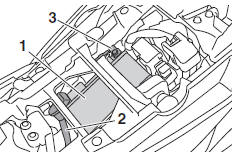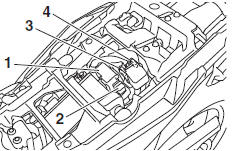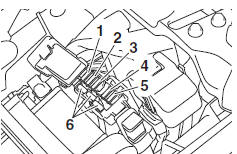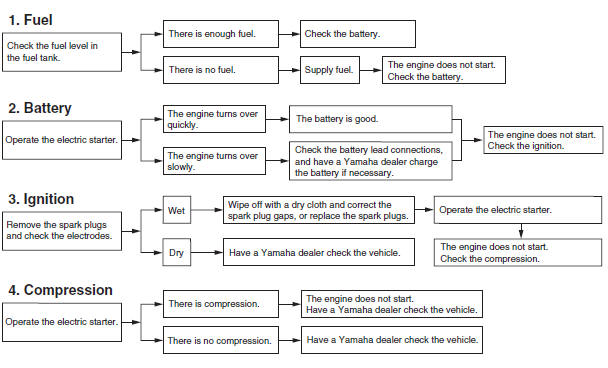 Yamaha Tracer MT09TRA - Owner's Manual > Battery
Yamaha Tracer MT09TRA - Owner's Manual > Battery

- Battery
- Positive battery lead (red)
- Negative battery lead (black)
The battery is located under the rider seat
This model is equipped with a VRLA (Valve Regulated Lead Acid) battery.
There is no need to check the electrolyte or to add distilled water. However, the battery lead connections need to be checked and, if necessary, tightened.
WARNING
Electrolyte is poisonous and dangerous since it contains sulfuric acid, which causes severe burns. Avoid any contact with skin, eyes or clothing and always shield your eyes when working near batteries. In case of contact, administer the following FIRST AID.
- EXTERNAL: Flush with plenty of water.
- INTERNAL: Drink large quantities of water or milk and immediately call a physician.
- EYES: Flush with water for 15 minutes and seek prompt medical attention.
Batteries produce explosive hydrogen gas. Therefore, keep sparks, flames, cigarettes, etc., away from the battery and provide sufficient ventilation when charging it in an enclosed space.
KEEP THIS AND ALL BATTERIES OUT OF THE REACH OF CHILDREN.
To charge the battery
Have a Yamaha dealer charge the battery as soon as possible if it seems to have discharged. Keep in mind that the battery tends to discharge more quickly if the vehicle is equipped with optional electrical accessories.
NOTICE
To charge a VRLA (Valve Regulated Lead Acid) battery, a special (constant- voltage) battery charger is required.
Using a conventional battery charger will damage the battery.
To store the battery
1. If the vehicle will not be used for more than one month, remove the battery, fully charge it, and then place it in a cool, dry place.
NOTICE: When removing the battery, be sure the key is turned to "OFF", then disconnect the negative lead before disconnecting the positive lead.
2. If the battery will be stored for more than two months, check it at least once a month and fully charge it if necessary.
3. Fully charge the battery before installation.
NOTICE: When installing the battery, be sure the key is turned to "OFF", then connect the positive lead before connecting the negative lead.
4. After installation, make sure that the battery leads are properly connected to the battery terminals
NOTICE
Always keep the battery charged.
Storing a discharged battery can cause permanent battery damage.
Replacing the fuses
The fuse boxes and individual fuses are located under the rider seat and behind panel A
To access fuse box 1, the main fuse, and the fuel injection system fuse, remove the rider seat.

- Fuse box 1
- Main fuse
- Fuel injection system fuse
- Fuel injection system spare fuse

- Radiator fan motor fuse
- Backup fuse (for clock and immobilizer system)
- Electronic throttle valve fuse
- ABS solenoid fuse
- ABS motor fuse
- Spare fuse
TIP
To access the fuel injection system fuse, remove the starter relay cover by pulling it upward.

- Starter relay cover
- Fuel injection system fuse
- Fuel injection system spare fuse
To access fuse box 2 and fuse box 3, remove panel A.

- Fuse box 2
- Fuse box 3

- Parking lighting fuse
- Headlight fuse
- Terminal fuse 2
- Terminal fuse 1
- Signaling system fuse
- Auxiliary fuse 1
- ABS control unit fuse
- Auxiliary fuse 2
- Spare fuse
- Ignition fuse
If a fuse is blown, replace it as follows.
1. Turn the key to "OFF" and turn off the electrical circuit in question.
2. Remove the blown fuse, and then install a new fuse of the specified amperage.
WARNING! Do not use a fuse of a higher amperage rating than recommended to avoid causing extensive damage to the electrical system and possibly a fire
Specified fuses:
Main fuse: 50.0 A
Auxiliary fuse 1: 2.0 A
Auxiliary fuse 2: 2.0 A
Terminal fuse 1: 2.0 A
Terminal fuse 2: 2.0 A
Headlight fuse: 7.5 A
Signaling system fuse: 7.5 A
Ignition fuse: 15.0 A
Parking lighting fuse: 7.5 A
Radiator fan motor fuse: 15.0 A
ABS motor fuse: 30.0 A
Fuel injection system fuse: 20.0 A
ABS solenoid fuse: 15.0 A
ABS control unit fuse: 7.5 A
Backup fuse: 7.5 A
Electronic throttle valve fuse: 7.5 A
3. Turn the key to "ON" and turn on the electrical circuit in question to check if the device operates.
4. If the fuse immediately blows again, have a Yamaha dealer check the electrical system.
Headlights
This model is equipped with LED-type headlights.
If a headlight does not come on, have a Yamaha dealer check its electrical circuit.
NOTICE
Do not affix any type of tinted film or stickers to the headlight lens.
Auxiliary lights

- Auxiliary light
This model is equipped with LED-type auxiliary lights.
If an auxiliary light does not come on, have a Yamaha dealer check it.
Brake/tail light
This model is equipped with an LED-type brake/tail light.
If the brake/tail light does not come on, have a Yamaha dealer check it.
Replacing a turn signal light bulb
1. Remove the turn signal light lens by removing the screw.

- Turn signal light lens
- Screw
2. Remove the burnt-out bulb by pushing it in and turning it counterclockwise.

- Turn signal light bulb
3. Insert a new bulb into the socket, push it in, and then turn it clockwise until it stops.
4. Install the lens by installing the screw.
NOTICE: Do not overtighten the screw, otherwise the lens may break.
Replacing the license plate light bulb
1. Remove the license plate light unit by removing the nuts and collars, and then remove the license plate light bulb socket (together with the bulb) by pulling it out.

- License plate light unit
- Collar
- Nut
- License plate light bulb socket
2. Remove the burnt-out bulb by pulling it out.

- License plate light bulb
3. Insert a new bulb into the socket.
4. Install the socket (together with the bulb) by pushing it in, and then install the license plate light unit by installing the collars and nuts.
Troubleshooting
Although Yamaha motorcycles receive a thorough inspection before shipment from the factory, trouble may occur during operation. Any problem in the fuel, compression, or ignition systems, for example, can cause poor starting and loss of power.
The following troubleshooting charts represent quick and easy procedures for checking these vital systems yourself.
However, should your motorcycle require any repair, take it to a Yamaha dealer, whose skilled technicians have the necessary tools, experience, and know-how to service the motorcycle properly.
Use only genuine Yamaha replacement parts. Imitation parts may look like Yamaha parts, but they are often inferior, have a shorter service life and can lead to expensive repair bills.
WARNING
When checking the fuel system, do not smoke, and make sure there are no open flames or sparks in the area, including pilot lights from water heaters or furnaces. Gasoline or gasoline vapors can ignite or explode, causing severe injury or property damage.
Troubleshooting charts
Starting problems or poor engine performance

Engine overheating
WARNING
- Do not remove the radiator cap when the engine and radiator are hot. Scalding hot fluid and steam may be blown out under pressure, which could cause serious injury. Be sure to wait until the engine has cooled.
- After removing the radiator cap retaining bolt, place a thick rag, like a towel, over the radiator cap, and then slowly rotate the cap counterclockwise to the detent to allow any residual pressure to escape. When the hissing sound has stopped, press down on the cap while turning it counterclockwise, and then remove the cap.

TIP
If coolant is not available, tap water can be temporarily used instead, provided that it is changed to the recommended coolant as soon as possible.
See also:
 Yamaha Tracer MT09TRA - Owner's Manual > Lubricating the swingarm pivots
Yamaha Tracer MT09TRA - Owner's Manual > Lubricating the swingarm pivots
The swingarm pivots must be lubricated by a Yamaha dealer at the intervals specified in the periodic maintenance and lubrication chart.

 BMW G310GS
BMW G310GS Honda CBR125RW
Honda CBR125RW Husqvarna 401 Vitpilen
Husqvarna 401 Vitpilen KTM 890 Duke R
KTM 890 Duke R Mash Dirt Track 650
Mash Dirt Track 650 Peugeot Kisbee
Peugeot Kisbee Yamaha Tracer MT-09
Yamaha Tracer MT-09 Honda CBR125RW
Honda CBR125RW Peugeot Kisbee
Peugeot Kisbee Yamaha Tracer MT-09
Yamaha Tracer MT-09